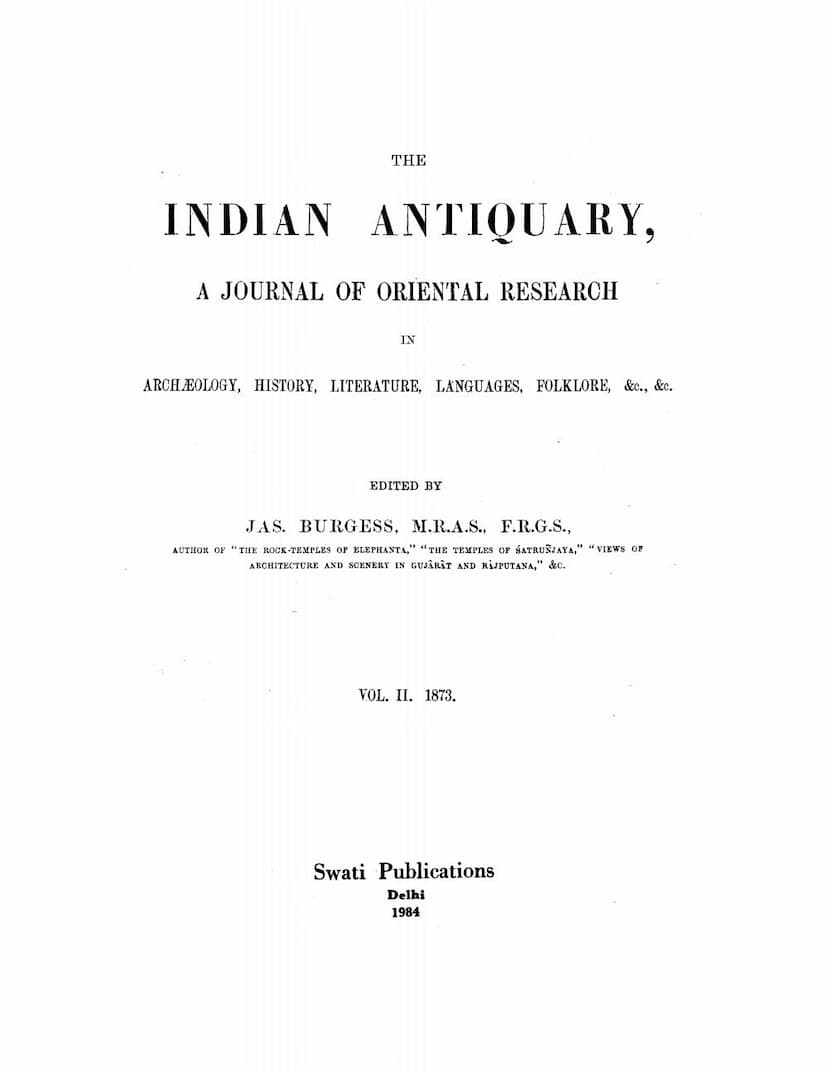Indian Antiquary Vol 02
Added to library: September 1, 2025

Summary
This compilation, titled "Indian Antiquary, Vol. II," published in 1873 and edited by Jas. Burgess, is a rich collection of articles offering insights into various aspects of Indian culture, history, archaeology, literature, and languages. While the book title itself doesn't specifically highlight a single Jain text, a closer examination of the comprehensive table of contents and the individual articles reveals several significant contributions related to Jainism.
Here's a summary of the key points relevant to Jainism found within this volume:
1. "On the Colossal Jaina Statue at Karkala" by A. C. Burnell (Mangalore):
- This article focuses on the architectural and artistic aspects of a significant Jaina statue, likely the Gomatesvara statue at Karkala, a major pilgrimage site. It would detail its physical dimensions, artistic style, and perhaps the legends or historical context surrounding its erection.
2. "PAPERS on SATRUNJAYA and the JAINS:-I. Kathiawad and the Jains" and "II. The Tirthankaras or Jinas" by THE EDITOR (JAS. BURGESS):
- Kathiawad and the Jains: This section likely discusses the geographical and historical significance of Kathiawad (Saurashtra) as a holy land for the Jains. It would detail their presence in this region, possibly mentioning important Jaina sites like Mount Girnar, and their reverence for places like Somnath and Dwarka. It would also explore the sect's followers in Gujarat, Dharwad, and Mysore, their name derived from "Jinas" or "conquerors of sins," and their belief in Nirvana. The article likely touches upon the Jain connection to Buddhism, their adherence to caste customs, and the origins of their sacred language (Ardha Magadhi).
- The Tirthankaras or Jinas: This is a crucial article, providing a detailed list and description of the twenty-four Tirthankaras, the spiritual hierarchs of Jainism. It would include their names, lineage, complexion, characteristic symbols (chinha), associated deities (Sasanadevi), physical stature, lifespan, places of birth and nirvana, and the legends associated with their lives. The article may also touch upon the classification of Tirthankaras (e.g., those of the present, past, and future cycles) and highlight the prominence of Rishabhanatha (Adinatha), Parsvanatha, and Mahavira. The mention of their connection to Brahmanical Puranic lists and the influence of Brahmanical ideas on Jain traditions would also be significant.
3. "The Desisabdāsangraha of Hemachandra" by G. BÜHLER (Gujarat):
- This article discusses the work of the renowned Jaina scholar Hemachandra (12th century). It focuses on his "Desisabdāsangraha," a Prakrit glossary containing approximately 4,000 Prakrit words with Sanskrit explanations. The article would detail the methodology, structure, and significance of this glossary for understanding the Prakrit vocabulary, highlighting its importance for philology due to its inclusion of words from spoken language. It would also mention Hemachandra's principles for word inclusion and his adherence to native traditions.
4. "The Early Vaishnava Poets of Bengal: I. Bidyapati" and a subsequent piece on "CHAITANYA and the VAISHNAVA POETS of BENGAL" by JOHN BEAMES:
- While primarily focusing on Vaishnavism, these articles provide context for the Bhakti movement and the literary landscape in which Jainism also existed. They mention earlier poets like Bidyapati and Chandi Das, who predated Chaitanya, and discuss the evolution of Bengali poetry. Though not directly about Jainism, understanding the broader religious and literary context of the time is valuable.
5. "The Jainas" by THE EDITOR (JAS. BURGESS):
- This section likely offers a general overview of Jainism, discussing its origins, core doctrines, and practices. It would elaborate on the denial of Vedic authority, reverence for Jinas, extreme emphasis on non-violence (ahimsa) through the five mahavratas, and the ascetic duties. The article might also explore their pantheon, including their relationship with Hindu deities, and their unique customs such as the use of brooms (Ugha) and mouth-cloths (Mohomati) to avoid harming insects. The possible connections and divergence from Buddhism would also be a key area.
6. "NOTES concerning the Numerals of the Ancient Dravidians" by REV. F. KITTEL:
- While the primary focus is on Dravidian numerals, the article indirectly touches upon cultural aspects that might have shared influences or existed alongside Jainism in South India. The mention of borrowings from Aryan languages and the potential influences between different tribal groups could offer comparative insights.
Overall Significance:
This volume of the Indian Antiquary serves as an invaluable resource for understanding the presence and significance of Jainism in India, particularly in the regions of Gujarat, Kathiawad, and South India. The articles shed light on:
- Jaina Archaeology: The physical remnants of Jaina presence, such as the statue at Karkala.
- Jaina History and Doctrine: The lineage of Tirthankaras, core beliefs, and the historical development of the sect.
- Jaina Literature and Language: The contributions of scholars like Hemachandra and the nature of Prakrit language.
- Cultural Context: The interaction of Jainism with other religious and cultural movements of the time, such as Vaishnavism and Buddhism.
In essence, this volume provides primary source material and scholarly analysis that are crucial for anyone studying the history and traditions of Jainism in ancient and medieval India.